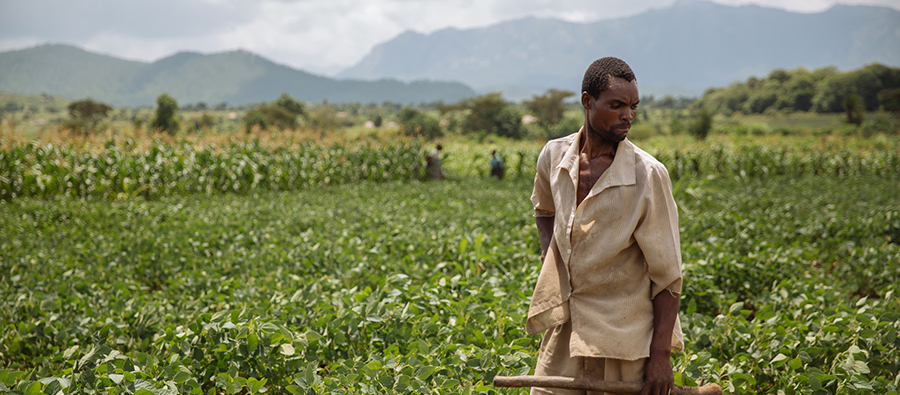What is agroecology? How can farmers be encouraged to adopt its principles? Professor Tim Benton, Dean of Strategic Research at Leeds University and former UK Global Food Security Champion answers these questions in the second installment of Farming First’s “Agroecology in Action” series, produced ahead of the Second International Symposium on Agroecology held by the FAO in Rome from 3-5th April 2018.
In scientific terms, “agroecology” refers to the application of ecological principles to agriculture – that is, harnessing nature to support agricultural production. Our planet depends on its ecological resilience, and it is important to find more sustainable methods of growing produce to allow production to be repeated time and time again.
Well known methods include crop rotation – planting a sequence of crops that will naturally improve soil fertility – or enhancing natural enemies to control pests on a farm.
From a science perspective, it is also credible to apply a “mix and match” approach, in which natural methods can work in synergy with more conventional farming methods. Using biology to control pests or rotations to grow fertility allows synthetic inputs to be used in more targeted ways, when, and where, they are most needed. If you are enhancing natural pest control, pesticides can become a last, rather than first, resort.
This can also apply to soil health. Severely degraded soils may produce too little yield to allow mulching for soil improvement and to encourage water retention. If you can use fertilizer to boost yields, you would then have enough biomass to use as both feed and compost in the future. This could well be beneficial to the environment in the long run.
Why agroecology matters now
Our food system faces a number of challenges. Greenhouse gas emissions must be reduced, yet our food supply to underpin healthy, nutritious diets, must continue to be secured. Our natural capital, soils, water, biodiversity must be maintained over the long term, so we can benefit from the services it provides.
Yet our food system doesn’t work well for many people. Under half the world’s population is a healthy weight, and more people are obese than underweight. Malnutrition in all its forms is driving an increasing global health crisis.
We need to think about transformational changes in how we farm and what we farm. This requires a shift in our mind set to focus not only on quantity but also quality and diversity of food. If we concentrate on designing a food system based on healthy diets, with low waste, we can create space where agro-ecological methods can better underpin agriculture.
Of course, these changes are not always easy or quick. Take the agroecological approach of conservation agriculture, for example. This relies on intercropping, minimal soil disturbance, and the use of cover crops to retain moisture and nutrients. This has been shown to improve yields whilst protecting soil health – but it can take several years before a farmer sees the benefits. For a subsistence farmer, this may simply not be a sacrifice he or she is willing to make unless they are somehow supported to do so.
Incentivizing the uptake of agroecology
Payment for ecosystem services is one way of incentivizing developing world farmers to adopt agroecological approaches. For example, in the districts upstream of the Shire River of Southern Malawi, we found that the adoption of conservation agriculture can reduce soil and sediment loss by around 65 per cent. When soil and sediment flow downstream, they severely disrupt the production of hydropower. Local hydropower plants are currently paying up to $150,000 per ton of sediment for its removal. However, if the electricity provider were to make payments instead to farmers, to encourage the adoption of conservation agriculture upstream, we estimate this would cost between $7 – $2,000 per ton of sediment avoided. In this way, farmers, the energy suppliers and citizens would all gain from more sustainable farming
This could also come in the form of adding a source of additional income for farmers. In Southern Côte d’Ivoire, integrated soil fertility management that intercropped cowpea with cassava – the main staple crop in the region – was developed. Drought tolerant, weed resistant and early maturing varieties of cassava were planted alongside cowpea, and fertilized with a mix of composted chicken manure and micro-doses (5 grams) of nitrogen, phosphorus and potassium per plant. Not only did cassava yields triple, but farmers were able to gain additional income from the cowpea, which could be harvested twice before the cassava crops reached maturity. Reduced weeding time and the high market value of cowpea caused the profitability to increase from around 200 to 2,500 Euros per hectare – all while the poor, sandy soils were benefitting from a fertility regime to replenish them for future use.
A financial reward to promote agroecological practices would be beneficial in the rest of the world too. Our food system is still underpinned by market incentives (in the form of subsidies) to produce a few commodity crops for the global market. There are six main breadbasket regions that produce the eight crops that provide around 75 per cent of the world’s calories. These crops (mostly cereals and grains) are calorie-rich, and because they are produced at very large scale, they are cheap and freely available. For many, this means that food waste, and over-consuming calories, becomes economically rational.
We need to make it more economically attractive to grow better and more diverse food, (particularly more fruit and vegetables) even if it means less food being produced (as our global food system is under 50% efficient, there is lots of scope for making the system more efficient). This will involve creating market incentives. In a sense, we have already done this to assist the transition from fossil fuels to renewable energy – by removing just a few per cent from the subsidies of fossil fuels and applying these to renewable energy, the playing field was levelled enough to allow for the latter to take off. Therefore, a rebalancing of subsidies to allow markets to provide food for health could make a huge difference.
People and the planet should be at the heart of food systems. Encouraging the adoption of agricultural practices that work alongside nature will allow us to move towards a more sustainable food system providing healthy diets for all. This will require collaborations and innovations across the whole value chain.
Further reading:
- IFPRI blog: Incentives could create a tipping point in conservation agriculture adoption
- Report: Sustainable intensification in agriculture: navigating a course through competing food system priorities
- World Economic Forum blog: What will we eat in 2030?
Featured photo: Soybean Farmer Walking through Field in Malawi – Mitchell Maher / International Food Policy Institute



